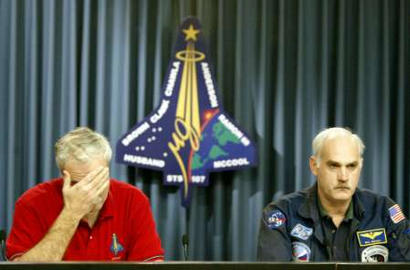The director of NASA says that if they had known that there was a real danger to the shuttle when it returned to the atmosphere, they would have found ways to rescue them * contrary to the words of the director of the shuttle program Ron Ditmore from which it was implied that the shuttle was lost * like Apollo 13
 NASA Administrator Sean O'Keefe rejects claims that nothing could have been done to save the space shuttle Columbia from crashing if the engineers knew it was in danger. "To say that nothing could be done is misleading. If there were clear signs that there was a problem, there would have been no end to the efforts we would have taken," O'Keefe told reporters who asked him to comment on the words of the flight program manager, Ron Ditmore. Dittmore was quoted as saying that the astronauts could not have been saved even if it was clearly known that the thermal tiles protecting her had been damaged. Hitting the tiles was one of the theories tested as the cause of the explosions.
NASA Administrator Sean O'Keefe rejects claims that nothing could have been done to save the space shuttle Columbia from crashing if the engineers knew it was in danger. "To say that nothing could be done is misleading. If there were clear signs that there was a problem, there would have been no end to the efforts we would have taken," O'Keefe told reporters who asked him to comment on the words of the flight program manager, Ron Ditmore. Dittmore was quoted as saying that the astronauts could not have been saved even if it was clearly known that the thermal tiles protecting her had been damaged. Hitting the tiles was one of the theories tested as the cause of the explosions.
O'Keefe cited the control room's response to the disaster that averted Apollo 13. Engineers expedited a way for the three Apollo astronauts to return to Earth after an oxygen tank exploded while the spacecraft was making its way to the moon. However, O'Keefe acknowledged that there was no written emergency plan that would cover the Columbia case, when a space shuttle is in orbit and its insulation tiles are damaged. He said that efforts to investigate the tiles using the Air Force's ground cameras were rejected (which showed defects on the left wing) because previous shots from those cameras did not provide helpful images.
As you may recall, the investigative committee investigating the disaster revealed a series of internal e-mail correspondences, from which it appears that five days before the Columbia shuttle crash, a number of engineers at NASA were concerned that it was suffering from damage that could pose a risk during landing. According to the emails, several engineers at the space agency expressed concern about the condition of the shuttle after liftoff, but the messages were not relayed to mission managers in Houston, Texas.
In contrast, various NASA officials, who knew about the damage that happened to the launch, assessed that it was not significant and determined that the shuttle's condition was fit for landing.
The disaster investigation also shows that NASA submitted a request to the US Air Force to conduct a telescope inspection of the damage caused to the shuttle during the launch, but this request was canceled before the inspection began.
"Why do we discuss the damage to the shuttle only the day before the landing and not the day after the launch?" wrote William Anderson, one of the engineers at NASA.
Another engineer who alerted was Robert Doherty, who works at the NASA Research Institute in Langley, Virginia. He wrote about the malfunctions in the landing pad and insulation tiles, a few days before the disaster. Doherty wrote that experts at NASA are concerned about the condition of the shuttle and that its condition is borderline, after it was damaged during launch. Other documents indicate that NASA engineers were concerned that the shuttle had been hit by three pieces of insulating foam during launch and not just one, as previously thought.
Doherty warned in an email he wrote on January 29, three days before the disaster, that one of the main concerns was that the damage to the insulation tiles near the wheelhouse could cause a hole. He expressed concern that the astronauts would try to land the shuttle with two damaged wheels as a result of the high heat. "We don't understand why receiving information is treated as a nuisance," wrote one of the engineers in the e-mail.
The investigative committee, which revealed the internal correspondence last week, now believes that the ferry suffered damage near the left passenger compartment, which contains the left wheels. From the latest data transmitted by Colombia, it appears that indeed in this area, under the left wing, a fault occurred which subsequently caused the crash, just as the engineer had warned.
A spokesman for the space agency, Dave Youngman, said that "the internal email correspondence was not prophetic. The engineers considered several scenarios and decided in the same period of time that there is no real cause for concern." However, Youngman added that "oddly, some of the scripts described quite accurately what really happened".
